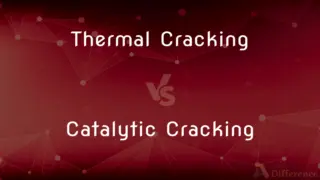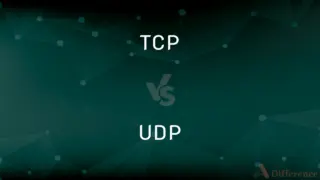End-stopped Line vs. Enjambment — What's the Difference?
Edited by Tayyaba Rehman — By Fiza Rafique — Published on December 8, 2023
End-stopped lines conclude with a natural pause; enjambment continues the sentence or phrase into the next line without pause.

Difference Between End-stopped Line and Enjambment
Table of Contents
ADVERTISEMENT
Key Differences
An End-stopped line in poetry is one where the line concludes with a natural pause, typically marked by punctuation such as a period, comma, or semicolon. On the other hand, enjambment occurs when the line doesn't stop at the end, and the sentence or thought flows over to the next line without a pause.
In the realm of poetry, End-stopped lines offer readers a moment to pause and digest the meaning of the line. Enjambment pushes the reader forward, maintaining the momentum of the thought or idea being conveyed. This difference in pacing can drastically alter the rhythm and mood of a poem.
End-stopped lines often provide a sense of completion, finality, or emphasis to the ideas they convey. They're like full stops in the narrative of a poem. Enjambment, conversely, offers a sense of continuity and can introduce tension, anticipation, or surprise, as the thought is unresolved until the next line or lines.
Using End-stopped lines can make a poem feel more formal, measured, or deliberate. Enjambment often gives the poem a more casual, conversational, or fluid feel, mirroring the natural flow of speech. Both techniques are valuable tools in a poet's arsenal, chosen based on the desired effect on the reader.
While both End-stopped lines and enjambment have their place in poetry, their utilization depends on the poet's intention. Whether seeking to evoke emotion, establish rhythm, or guide interpretation, the choice between an End-stopped line and enjambment plays a critical role in shaping the poem's impact.
ADVERTISEMENT
Comparison Chart
Definition
Concludes with a natural pause
Continues into the next line without a pause
Punctuation
Typically marked by punctuation
Often lacks punctuation at the end of the line
Effect on Pace
Offers a moment to pause
Pushes the reader forward
Feel
Provides a sense of completion or finality
Gives a sense of continuity or tension
Typical Use
Makes a poem feel more formal or deliberate
Makes a poem feel more casual or fluid
Compare with Definitions
End-stopped Line
Concludes a thought or idea.
In her eyes, there's a radiant blue.
Enjambment
Creates continuation without a clear pause.
In the depth of night, when all is
End-stopped Line
A line of poetry that ends with punctuation.
The sun sets, casting a golden hue.
Enjambment
Often gives a poem a conversational feel.
I dream of a world where love is
End-stopped Line
Offers completion to its statement.
The night arrives, stars begin to strew.
Enjambment
A poetic device where the line runs over to the next.
The river flows, swift and
End-stopped Line
Provides a defined pause in verse.
Birds sing, and the world feels new.
Enjambment
Used to maintain momentum in poetry.
The wind whispers secrets, soft and
End-stopped Line
Establishes measured pacing in a poem.
Dreams wander, as they often do.
Enjambment
Introduces tension by delaying completion.
The mountain's peak, so high it
Enjambment
The continuation of a syntactic unit from one line or couplet of a poem to the next with no pause.
Enjambment
A technique in poetry whereby a sentence is carried over to the next line without pause.
Enjambment
The continuation of a syntactic unit from one line of verse into the next line without a pause
Common Curiosities
What is Enjambment?
A poetic technique where the thought or sentence continues into the next line without a clear pause.
What is an End-stopped Line?
A line in poetry that concludes with a natural pause, often marked by punctuation.
Why would a poet use Enjambment?
To maintain momentum, introduce tension, or give the poem a conversational or fluid feel.
Does an End-stopped Line always have punctuation?
Typically, yes. Punctuation like a period, comma, or semicolon usually marks the end of an End-stopped line.
Can a poem use both End-stopped Lines and Enjambment?
Yes, many poems combine both techniques for varied rhythm and effect.
What effect does an End-stopped Line have on readers?
It offers a moment to pause and reflect on the line's meaning.
Are End-stopped Lines formal?
They can lend a more formal, measured feel to a poem, but context matters.
How does Enjambment affect a poem's mood?
It can introduce tension, surprise, or a more casual tone, depending on its use.
Does Enjambment alter a poem's rhythm?
Yes, it can create a sense of urgency, anticipation, or natural flow.
Can Enjambment occur in prose?
While most common in poetry, enjambment-like effects can be seen in prose, especially where line breaks play a role.
Why are End-stopped Lines significant in poetry?
They provide emphasis, rhythm, and can help structure a poem's narrative or theme.
Which poets frequently used Enjambment?
Many poets, from Shakespeare to E.E. Cummings, have used enjambment for various effects.
Is Enjambment modern?
No, it's been used for centuries across various languages and poetic traditions.
Is it necessary to choose between End-stopped Line and Enjambment in a poem?
No, they can coexist, and many poems effectively blend the two techniques.
How do I recognize an End-stopped Line?
Look for a natural pause at the end, often marked by punctuation.
Share Your Discovery

Previous Comparison
Thermal Cracking vs. Catalytic Cracking
Next Comparison
TCP vs. UDPAuthor Spotlight
Written by
Fiza RafiqueFiza Rafique is a skilled content writer at AskDifference.com, where she meticulously refines and enhances written pieces. Drawing from her vast editorial expertise, Fiza ensures clarity, accuracy, and precision in every article. Passionate about language, she continually seeks to elevate the quality of content for readers worldwide.
Edited by
Tayyaba RehmanTayyaba Rehman is a distinguished writer, currently serving as a primary contributor to askdifference.com. As a researcher in semantics and etymology, Tayyaba's passion for the complexity of languages and their distinctions has found a perfect home on the platform. Tayyaba delves into the intricacies of language, distinguishing between commonly confused words and phrases, thereby providing clarity for readers worldwide.














































